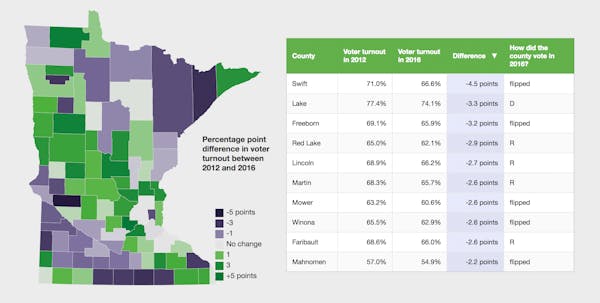Minnesota leads the nation in voter turnout for the second presidential election in a row – and for the eighth time in the past nine presidential elections.
While Minnesota's turnout downturned slightly compared to 2012, its high voter participation rates easily placed it atop the pack once again, according to the sixth biennial America Goes to the Polls report from Nonprofit VOTE and the US Elections Project.
"Minnesota has developed a strong civic culture around voting," something that helps separate it from other states, said George Pillsbury, author of the report and senior consultant for Nonprofit VOTE.
About 75 percent of eligible Minnesota voters cast ballots in the 2016 election. The state was among only five that managed to break into the seventieth percentile, a roster that also includes Maine, New Hampshire, Colorado and Wisconsin.
Something else each of those states has in common is same-day voter registration, which the report said contributed to high voter participation. Voter access, electoral competition and how effectively the campaigns mobilized their supporters were also factors driving people to the polls.
States with same-day voter registration saw an average turnout seven points higher than states lacking the option, according to the report.
Minnesota has allowed same-day registration since 1974, and was among the first to adopt it along with Maine, followed shortly thereafter by Wisconsin.
Yet, Wisconsin was the only state with same-day registration that saw a large drop in voter turnout, falling about 3 points as the state slid from being ranked second in 2012 to fifth in 2016.
Automatic voter registration also gets a nod in the report, with Oregon being the first state to implement it by registering citizens via DMV transactions, leading to a 4-point jolt in turnout since 2012, the highest increase of any state between the elections.
On the lower end of the scale are states like Oklahoma, Arkansas, Tennessee, Texas, West Virginia, and Hawaii, all with turnout of 53 percent or less. The latter five states were grouped at the bottom for the third presidential election in a row.
About 60 percent of eligible voters nationally turned out on Election Day -- about a one-point increase from 2012 and the second highest turnout for a presidential contest since 1971, when the voting age was lowered to 18-years-old. Forty percent of eligible voters didn't cast ballots, according to the report, attributable to problems with registration, a lack of desirable candidate choices, lack of faith in the electoral process or challenges making it to the polls.
Once again, low turnout in California, New York and Texas – which represent about 25 percent of the eligible voting population – brought down the national voting rates, according to the report, which said turnout could have been 1.5 points higher had they matched the pace of other states.
The report also found, contrary to conventional wisdom since Election Day, that turnout among voters aged 18 to 29 had actually increased five points in 2016 compared to 2012. About 8 percent of voters aged 18 to 44 also supported third party candidates, according to the report, a rate more than double that of voters over 45-years-old.
Pillsbury said that online registration – now available in 34 states – has helped drive greater engagement among younger voters, and that same-day registration has also been useful that regard.
Many of the top-ranking states for voter turnout were also battleground states where the report said turnout was five to eight points higher than other states in the past five presidential elections. Only about 35 percent of eligible voters lived in a 2016 battleground state.
Still, those states got a lot of attention from the presidential campaigns, with Florida, Ohio, Pennsylvania and North Carolina attracting the most ad spending and appearances by candidates.
All that attention, along with high voter turnout, contributed to razor-thin margins in many battleground states. Similarly, in Minnesota, Hillary Clinton only edged out Donald Trump by a couple points to claim the state's electoral votes.
Minnesota also had several competitive congressional and local races. But competition overall in 2016 was the lowest in 30 years, according to the report, with only 37 of 435 seats considered to be in play prior to Election Day. Nearly three-quarters of House races were either won by 20 percent or more, or were simply unopposed.
"At the end of the day, voters want a meaningful choice when they go to the polls," Pillsbury said.

Souhan: This is KAT's chance to prove Flip was right

